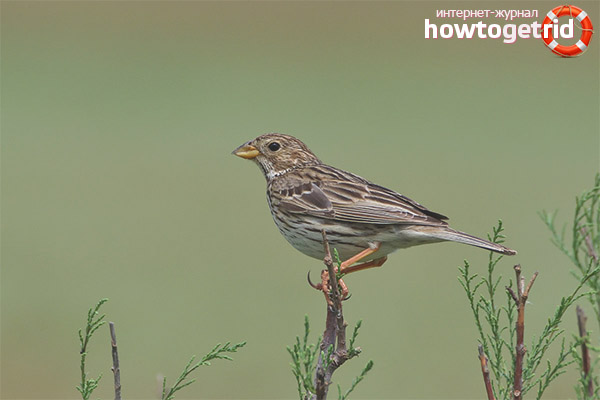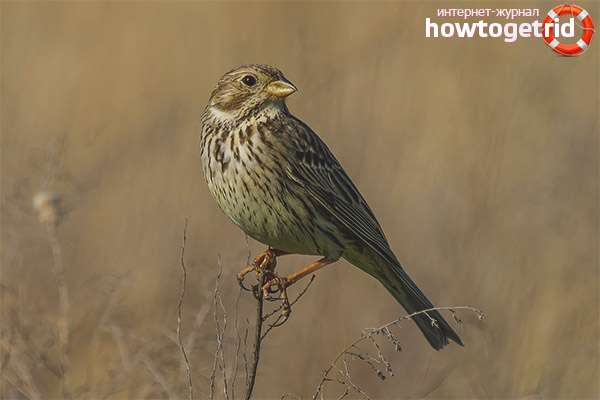The content of the article
The sunflower bird belongs to the order of the passerine family of oatmeal.
Appearance and behavior
Outwardly, it is a rather large bird slightly smaller than a starling, with a large head and a relatively short tail. Although it belongs to oatmeal, the color of plumage and physique is closer to the steppe larks.
Regardless of gender and age, the plumage of a bird is quite similar, but the young growth is slightly darker with a pronounced olive-brownish color. The upper side of the body, wings and tail are characterized by gray-brown shades interspersed with light and dark spots. The lower part of the body (chest and tummy) has a lighter shade of off-white color with brown streaks. In some birds, the streaks on the breast merge into one dark spot. The tail has a monochromatic grayish-brown hue without white spots. Plain are the loins, underparts and underparticles having a dark brown color. The beak of the millet is massive brownish-ocher shades, slightly swollen, the upper and lower parts of which are slightly curved inward so that it does not close completely. Her legs are light flesh-colored with a pink tinge.
The size and weight of the bird is also gender independent. The weight of an adult is in the range of 38-56g. The body length can vary from 17 to 19 cm, and the wingspan is from 26 to 32 cm. In the millet there is a slight difference between females and males in the length of the wings, tail and beak. So, in females the wings reach 9 cm, the tail - 6.5 cm, the beak - 1 cm, and in the male 10.5-11 cm, 2.5 cm and 1.5 cm, respectively. When flying, the wings of a bird have peaks, like those of a lark, and when taking off, they often do not press their paws to the body.
Being by nature an unobtrusive bird, millet can often be found sitting on poles, on tops of large and tall grass, power lines and buildings.
Habitat
Often it can be found in fields sown with millet or potatoes, near residential buildings and roads among flood meadows, held in pairs. The birds separate only at the time of singing, when they sit on the neighboring and approximately equal in height peaks of the trees, and then reassemble in one place. Often lives in the west of the Palearctic near Denmark, on the British Isles and Canaries. It is quite common from the north-west of the African continent to the territories of the Middle East, the northern part of Iran, and it can also be seen in the mountainous and foothill areas of Central Asia.
As for the Russian Federation, millet is found in the forest-steppe territories of the European part, the Caucasus and Ciscaucasia. The density of its distribution is also different, since in some areas you can hardly see a bird, in others it is common for people to see it.
Nutrition

For the most part, the diet of millet consists of seeds of cereal crops and other herbs. An exception is only in the summer and spring, when the birds partially switch to the consumption of small insects.
Breeding
Usually in one clutch there are from 4 to 5 eggs of large size with a white and pinkish shell with brownish marks. Only the female is engaged in hatching the masonry for 12-13 days, only leaving the nest for some time. The hatched chicks in the first days of their life receive food mainly from their mother, and only in the very last days their father begins to feed them. According to the observations of scientists, feeding the chicks by their parents is about 13-17 times per hour. The chicks grow rapidly and already on the 9-12th day from the moment of birth they leave the family nest.
It often happens that after the first brood, adults begin to build a new nest, thereby preparing for the second clutch.
Video: millet (Emberiza calandra)










Submit